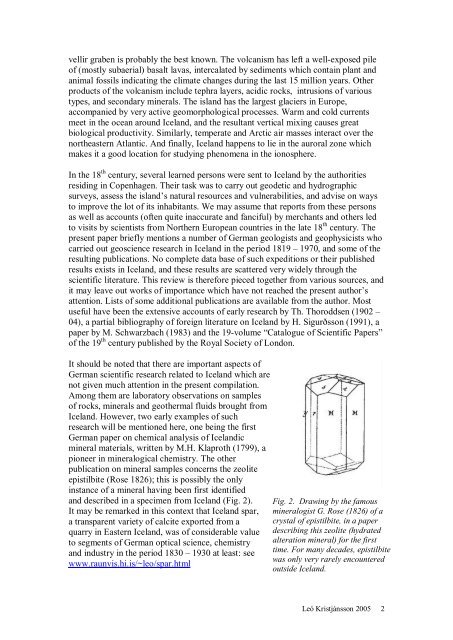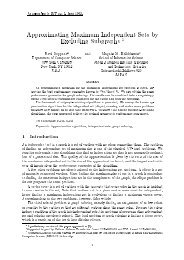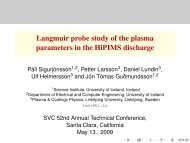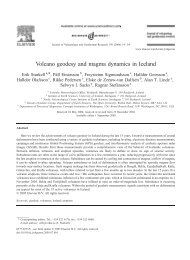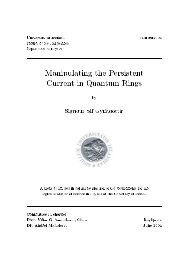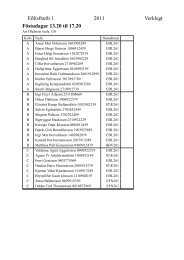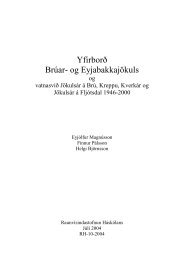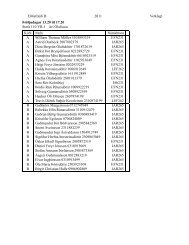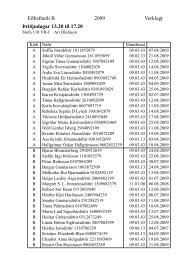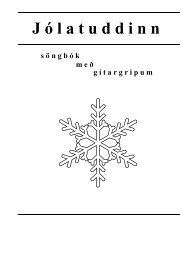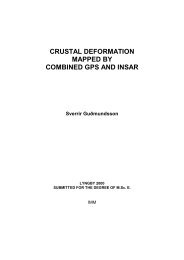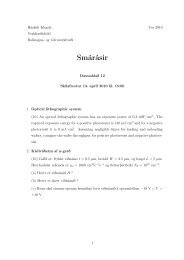Historical Notes on Earth Science Research in Iceland by German ...
Historical Notes on Earth Science Research in Iceland by German ...
Historical Notes on Earth Science Research in Iceland by German ...
You also want an ePaper? Increase the reach of your titles
YUMPU automatically turns print PDFs into web optimized ePapers that Google loves.
vellir graben is probably the best known. The volcanism has left a well-exposed pileof (mostly subaerial) basalt lavas, <strong>in</strong>tercalated <strong>by</strong> sediments which c<strong>on</strong>ta<strong>in</strong> plant andanimal fossils <strong>in</strong>dicat<strong>in</strong>g the climate changes dur<strong>in</strong>g the last 15 milli<strong>on</strong> years. Otherproducts of the volcanism <strong>in</strong>clude tephra layers, acidic rocks, <strong>in</strong>trusi<strong>on</strong>s of varioustypes, and sec<strong>on</strong>dary m<strong>in</strong>erals. The island has the largest glaciers <strong>in</strong> Europe,accompanied <strong>by</strong> very active geomorphological processes. Warm and cold currentsmeet <strong>in</strong> the ocean around <strong>Iceland</strong>, and the resultant vertical mix<strong>in</strong>g causes greatbiological productivity. Similarly, temperate and Arctic air masses <strong>in</strong>teract over thenortheastern Atlantic. And f<strong>in</strong>ally, <strong>Iceland</strong> happens to lie <strong>in</strong> the auroral z<strong>on</strong>e whichmakes it a good locati<strong>on</strong> for study<strong>in</strong>g phenomena <strong>in</strong> the i<strong>on</strong>osphere.In the 18 th century, several learned pers<strong>on</strong>s were sent to <strong>Iceland</strong> <strong>by</strong> the authoritiesresid<strong>in</strong>g <strong>in</strong> Copenhagen. Their task was to carry out geodetic and hydrographicsurveys, assess the island’s natural resources and vulnerabilities, and advise <strong>on</strong> waysto improve the lot of its <strong>in</strong>habitants. We may assume that reports from these pers<strong>on</strong>sas well as accounts (often quite <strong>in</strong>accurate and fanciful) <strong>by</strong> merchants and others ledto visits <strong>by</strong> scientists from Northern European countries <strong>in</strong> the late 18 th century. Thepresent paper briefly menti<strong>on</strong>s a number of <strong>German</strong> geologists and geophysicists whocarried out geoscience research <strong>in</strong> <strong>Iceland</strong> <strong>in</strong> the period 1819 – 1970, and some of theresult<strong>in</strong>g publicati<strong>on</strong>s. No complete data base of such expediti<strong>on</strong>s or their publishedresults exists <strong>in</strong> <strong>Iceland</strong>, and these results are scattered very widely through thescientific literature. This review is therefore pieced together from various sources, andit may leave out works of importance which have not reached the present author’sattenti<strong>on</strong>. Lists of some additi<strong>on</strong>al publicati<strong>on</strong>s are available from the author. Mostuseful have been the extensive accounts of early research <strong>by</strong> Th. Thoroddsen (1902 –04), a partial bibliography of foreign literature <strong>on</strong> <strong>Iceland</strong> <strong>by</strong> H. Sigurðss<strong>on</strong> (1991), apaper <strong>by</strong> M. Schwarzbach (1983) and the 19-volume “Catalogue of Scientific Papers”of the 19 th century published <strong>by</strong> the Royal Society of L<strong>on</strong>d<strong>on</strong>.It should be noted that there are important aspects of<strong>German</strong> scientific research related to <strong>Iceland</strong> which arenot given much attenti<strong>on</strong> <strong>in</strong> the present compilati<strong>on</strong>.Am<strong>on</strong>g them are laboratory observati<strong>on</strong>s <strong>on</strong> samplesof rocks, m<strong>in</strong>erals and geothermal fluids brought from<strong>Iceland</strong>. However, two early examples of suchresearch will be menti<strong>on</strong>ed here, <strong>on</strong>e be<strong>in</strong>g the first<strong>German</strong> paper <strong>on</strong> chemical analysis of <strong>Iceland</strong>icm<strong>in</strong>eral materials, written <strong>by</strong> M.H. Klaproth (1799), api<strong>on</strong>eer <strong>in</strong> m<strong>in</strong>eralogical chemistry. The otherpublicati<strong>on</strong> <strong>on</strong> m<strong>in</strong>eral samples c<strong>on</strong>cerns the zeoliteepistilbite (Rose 1826); this is possibly the <strong>on</strong>ly<strong>in</strong>stance of a m<strong>in</strong>eral hav<strong>in</strong>g been first identifiedand described <strong>in</strong> a specimen from <strong>Iceland</strong> (Fig. 2). Fig. 2. Draw<strong>in</strong>g <strong>by</strong> the famousIt may be remarked <strong>in</strong> this c<strong>on</strong>text that <strong>Iceland</strong> spar, m<strong>in</strong>eralogist G. Rose (1826) of aa transparent variety of calcite exported from a crystal of epistilbite, <strong>in</strong> a paperquarry <strong>in</strong> Eastern <strong>Iceland</strong>, was of c<strong>on</strong>siderable value describ<strong>in</strong>g this zeolite (hydratedto segments of <strong>German</strong> optical science, chemistry alterati<strong>on</strong> m<strong>in</strong>eral) for the firstand <strong>in</strong>dustry <strong>in</strong> the period 1830 – 1930 at least: see time. For many decades, epistilbitewas <strong>on</strong>ly very rarely encounteredwww.raunvis.hi.is/~leo/spar.htmloutside <strong>Iceland</strong>.Leó Kristjánss<strong>on</strong> 2005 2


